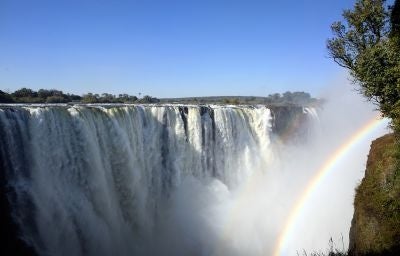Your support helps us to tell the story
From reproductive rights to climate change to Big Tech, The Independent is on the ground when the story is developing. Whether it's investigating the financials of Elon Musk's pro-Trump PAC or producing our latest documentary, 'The A Word', which shines a light on the American women fighting for reproductive rights, we know how important it is to parse out the facts from the messaging.
At such a critical moment in US history, we need reporters on the ground. Your donation allows us to keep sending journalists to speak to both sides of the story.
The Independent is trusted by Americans across the entire political spectrum. And unlike many other quality news outlets, we choose not to lock Americans out of our reporting and analysis with paywalls. We believe quality journalism should be available to everyone, paid for by those who can afford it.
Your support makes all the difference.The publication of a new tourist guide to Zimbabwe this summer could represent a flicker of hope for the country's ravaged tourism industry.
It's hard to believe, but 20 years ago, the country that boasts natural wonders such as Victoria Falls and several ancient UNESCO World Heritage sites was the jewel in Africa's crown. Until Robert Mugabe's disastrous land reform program began in 2000, tourism was growing steadily.
Tourist arrivals plunged from 1.4 million in 2000 to 223,000 in 2008. Since then, Zimbabwe's beautiful landscapes have been seen by an ever-shrinking group of tourists as hyperinflation ravaged the economy and led to widespread poverty.
Now, there is light at the end of the tunnel. The power-sharing deal signed in 2009 by President Robert Mugabe and Prime Minister Morgan Tsvangirai led to the elimination of the Zimbabwean dollar as a currency and after 12 months of dealing in US dollars, the tourism infrastructure is improving. Zimbabweans hope that the 2010 FIFA World Cup in neighbouring South Africa could also provide a boost.
Bradt's Zimbabwe, the first tourist guide to be published since the historic agreement, takes a look at some of Zimbabwe's incredible national parks, ancient monuments (the history of the national bird that appears on its flag) and the vibrant culture of its people. Above all, it tries hard to dispel the myth that Zimbabwe is dangerous for tourists.
"I can't stress this enough, you don't need to be intrepid, brave, or, as many people think, stupid, to come to Zimbabwe as it is safe, safe, safe for visitors," said Paul Murray, who spent four years driving across the country researching the book.
"The economy is on the move again so everybody is champing at the bit to welcome tourists back to this stunningly attractive country; all it just needs is for the recession to end."
British explorer Sir Ranulph Fiennes, who wrote the foreword to the guide, took his wife and children to Zimbabwe in 2007 and agrees with Murray.
"From what I've seen of Zimbabwe, it's perfectly safe for tourists," he said. "By staying away, all you're doing is making things even harder for all the people involved in tourism and conservation here and depriving yourself of a fantastic time."
Both men are unequivocal in their support and admiration for ordinary Zimbabweans, who are desperate for change and a chance to rebuild their country.
The message is clear - Zimbabwe is more open for business now than it has been for the past ten years and a well-deserved change in the fortune of its people seems be on the horizon.
Bradt's Zimbabwe is released in Europe in May, priced £15.99/€27.00, and the US in September, priced $25.99.
http://www.bradtguides.com/
http://www.zimbabwetourism.co.zw

Join our commenting forum
Join thought-provoking conversations, follow other Independent readers and see their replies
Comments